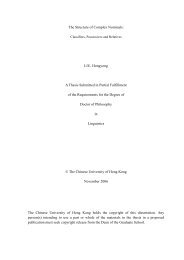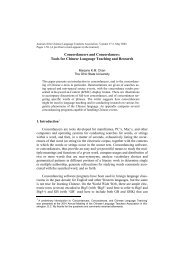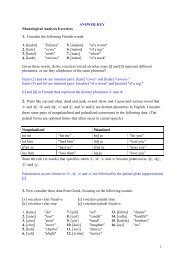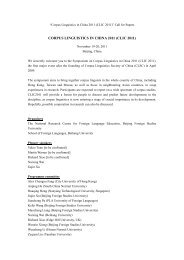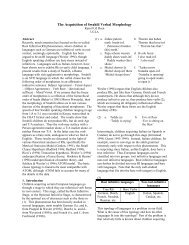The mnemonic keyword method: The effects of bidirectional retrieval ...
The mnemonic keyword method: The effects of bidirectional retrieval ...
The mnemonic keyword method: The effects of bidirectional retrieval ...
You also want an ePaper? Increase the reach of your titles
YUMPU automatically turns print PDFs into web optimized ePapers that Google loves.
M. Wyra et al. / Learning and Instruction 17 (2007) 360e371<br />
369<br />
students learning Italian. As was the case in that study the positive impact <strong>of</strong> learning is strongest for recall following<br />
the initial learning occasions. <strong>The</strong> positive slope across the multiple occasions used in the current study is noteworthy<br />
given other research described earlier that has shown decline in recall when a smaller number <strong>of</strong> recall occasions has<br />
been used.<br />
<strong>The</strong>re was a significant impact <strong>of</strong> the <strong>retrieval</strong> training on recall score compared to that associated with the standard<br />
<strong>keyword</strong> training. Again the size <strong>of</strong> the benefit from <strong>retrieval</strong> training was as <strong>of</strong> practical significance. When compared<br />
with the traditional <strong>keyword</strong> training, reports <strong>of</strong> which give most emphasis to encoding, the relatively simple explicit<br />
training in use <strong>of</strong> the <strong>keyword</strong> procedure for <strong>retrieval</strong> was associated with successful recall <strong>of</strong> not only definitions<br />
(FWR) but also with successful recall <strong>of</strong> Spanish words (BWR). <strong>The</strong> fact that the impact <strong>of</strong> the <strong>retrieval</strong> training<br />
occurred for both forward and backward recall is also important because it indicates that students gained benefit<br />
from this additional training for both receptive and productive vocabulary use.<br />
<strong>The</strong> difference in level <strong>of</strong> recall in forward and backward directions mirrors that found in previous research (Ellis &<br />
Beaton, 1993). Ellis and Beaton (1993) suggest that backward recall is more complex because there are ‘‘many more<br />
competing active paths in production [backward recall] than in reception [forward recall].’’ (p. 549). It is not clear<br />
from their description what these authors meant by ‘active paths’. Examination <strong>of</strong> the descriptions <strong>of</strong> <strong>retrieval</strong> processes<br />
involved in forward and backward directions suggests some ways in which the demands on the learner could<br />
be different in the two directions. We base this argument on the analysis <strong>of</strong> the forward and backward <strong>retrieval</strong> processes<br />
shown in Fig. 2. We think that the number <strong>of</strong> associations is relatively similar in both directions <strong>of</strong> recall. <strong>The</strong><br />
learner has to retrieve an image <strong>of</strong> the definition (in backward recall, see Fig. 2 step 1B) or an image <strong>of</strong> the <strong>keyword</strong> (in<br />
forward recall, see Fig. 2 step 2F). Each task involving native language words would potentially stimulate comparable<br />
number <strong>of</strong> activations. Alternatively, Ellis and Beaton suggest that the strictness <strong>of</strong> scoring <strong>of</strong> acceptable responses is<br />
likely to act to disadvantage recall performance in the backward direction.<br />
In Fig. 2 the central row <strong>of</strong> boxes identifies phases <strong>of</strong> representation and the arrows in both directions indicate broad<br />
processes that bring about changes in representation. Thus, as described in the forward path legend at the top <strong>of</strong> the<br />
figure, process 1F involves scanning <strong>of</strong> the foreign word to search for and select the <strong>keyword</strong> that was used during<br />
encoding. Other process descriptions in the forward direction and those in the backward direction are given in the<br />
respective legends in the Fig. 2.<br />
<strong>The</strong> model set out in Fig. 2 suggests that the number <strong>of</strong> competing active paths would be the same for the forward<br />
and backward recall. In FWR demand on the student in terms <strong>of</strong> the number <strong>of</strong> possible paths that could be activated<br />
would seem to be greatest in steps 2F, 3F and 5F. For BWR, steps 1B, 2B and 5B would also involve high demand<br />
FORWARD PATH<br />
1F – scanning FW for <strong>keyword</strong> (KW), generating and/or searching, selecting<br />
2F – searching for pictorial image/s <strong>of</strong> KW<br />
3F – searching for interaction (as per encoding and <strong>retrieval</strong> training conditions), generating and/or searching, selecting<br />
4F – selecting the pictorial image <strong>of</strong> definition from the (as per encoding and <strong>retrieval</strong> training conditions)<br />
5F – interpretation <strong>of</strong> image to recall the definition<br />
1F 2F 3F 4F 5F<br />
FOREIGN WORD<br />
KW<br />
IMAGE<br />
OF KW<br />
IMAGE<br />
OF<br />
INTERA<br />
CTION<br />
IMAGE<br />
OF<br />
DEFINITION<br />
DEFINITION<br />
apio<br />
5B<br />
ape<br />
4B<br />
3B 2B 1B<br />
celery<br />
BACKWARD PATH<br />
1B – searching for pictorial image <strong>of</strong> definition, generating and/or searching, selecting<br />
2B – searching for image <strong>of</strong> interaction (as per encoding and <strong>retrieval</strong> training conditions)<br />
3B – selecting the pictorial image <strong>of</strong> <strong>keyword</strong> (KW) (as per encoding and <strong>retrieval</strong> training conditions)<br />
4B – interpretation <strong>of</strong> the image <strong>of</strong> KW to recall the image <strong>of</strong> the spelling <strong>of</strong> KW<br />
5B – searching for or generating, selecting the foreign word<br />
Fig. 2. Retrieval phases and broad processes involved in forward and backward directions.



